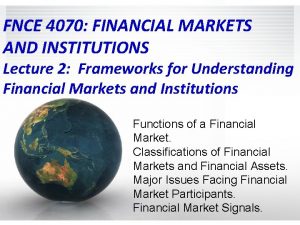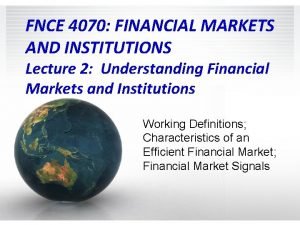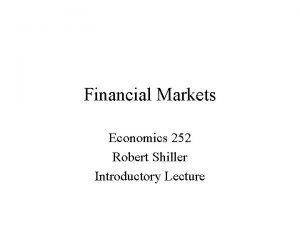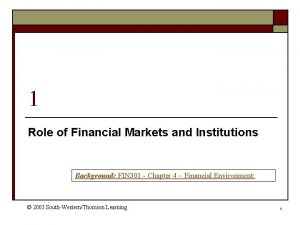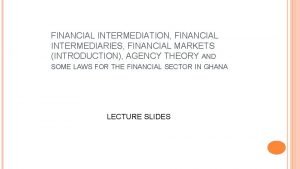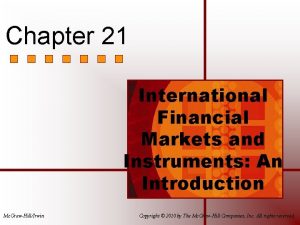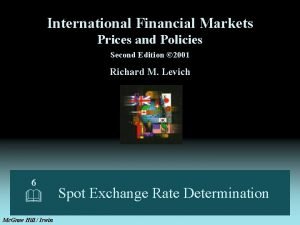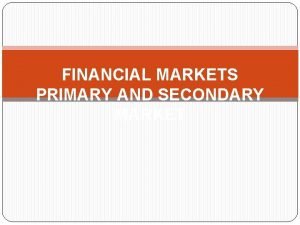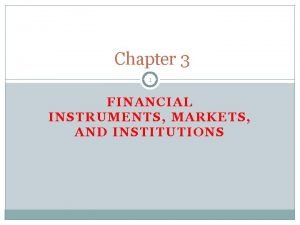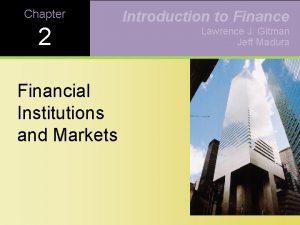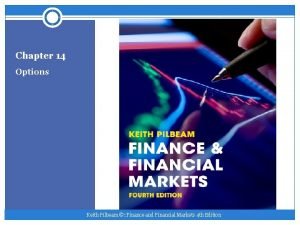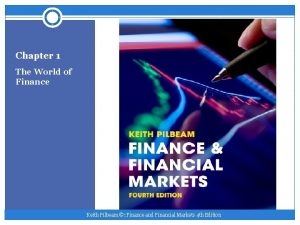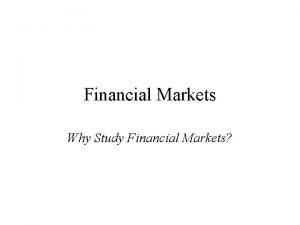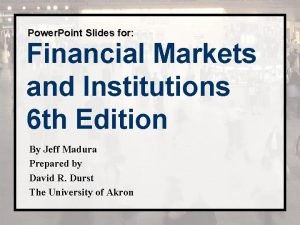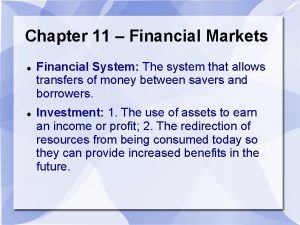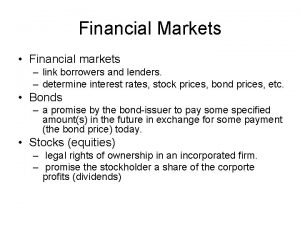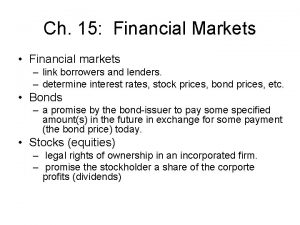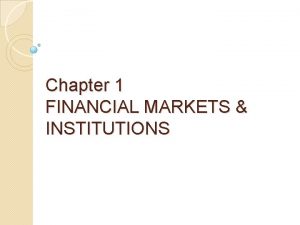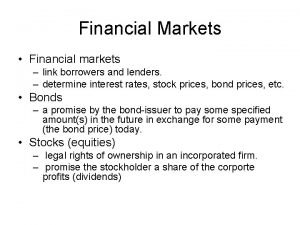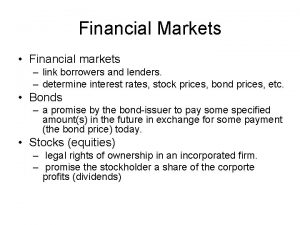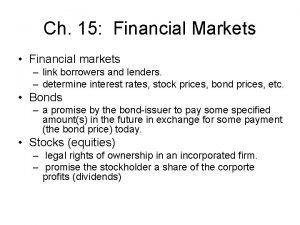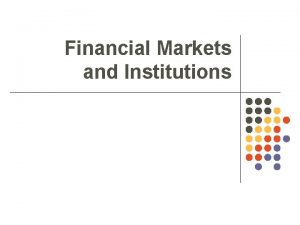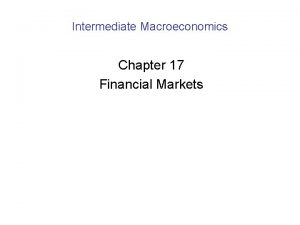The Financial Markets Financial markets represent a system
























- Slides: 24

The Financial Markets ○ Financial markets represent a system that includes individuals and institutions, instruments, and procedures that bring together borrowers and savers, no matter the location. ○ The primary role of financial markets is to facilitate the flow of funds from individuals and businesses that have surplus funds to individuals, businesses, and governments that need funds in excess of their incomes. © 2017 Cengage Learning. All Rights Reserved. May not be copied, scanned, or duplicated, in whole or in part, except for use as permitted in a license distributed with a certain product or service or otherwise on a password-protected website for classroom use. 1

Flow of Funds ○ Three financial phases q q q Young adults borrow Older working adults save Retired adults use savings ○ Funds transferred from savers to borrowers q Direct transfer q Investment banking house q Financial intermediary © 2017 Cengage Learning. All Rights Reserved. May not be copied, scanned, or duplicated, in whole or in part, except for use as permitted in a license distributed with a certain product or service or otherwise on a password-protected website for classroom use. 2

Diagram of the Capital Formation Process 1. Direct Transfers Business’s Securities (Stocks or Bonds) Business (Borrower) Savers (Investors) Funds 2. Indirect Transfers through an Investment Banker Business (Borrower) Securities (Stocks/Bonds) Funds less issuing costs Investment Banker Helps corporations issue securities (stocks or bonds) Receives fees from the issue Firm’s Stocks or Bonds Savers (Investors) Funds 3. Indirect Transfers through a Financial Intermediary Business (Borrower) (Debt owed to intermediary) Borrower’s Liability Funds Financial Intermediary Uses funds to buy/create loans and other financial instruments Pays a return/interest to attract funds from savers Intermediary’s Liability (Account at intermediary) Savers (Investors) Funds © 2017 Cengage Learning. All Rights Reserved. May not be copied, scanned, or duplicated, in whole or in part, except for use as permitted in a license distributed with a certain product or service or otherwise on a password-protected website for classroom use. 3

Market Efficiency ○ Economic Efficiency - Funds are allocated to their optimal use at the lowest costs. © 2017 Cengage Learning. All Rights Reserved. May not be copied, scanned, or duplicated, in whole or in part, except for use as permitted in a license distributed with a certain product or service or otherwise on a password-protected website for classroom use. 4

Market Efficiency (cont. ) ○ Informational Efficiency—investment prices are adjusted quickly to reflect current information. q q q Weak-form—all information contained in past price movements is reflected in current market prices. Semistrong-form—current prices reflect all publicly available information. Strong-form—current prices reflect all pertinent information, both public and private. © 2017 Cengage Learning. All Rights Reserved. May not be copied, scanned, or duplicated, in whole or in part, except for use as permitted in a license distributed with a certain product or service or otherwise on a password-protected website for classroom use. 5

Types of Financial Markets ○ Money markets versus capital markets ○ Debt markets versus equity markets ○ Primary markets versus secondary markets ○ Derivatives markets © 2017 Cengage Learning. All Rights Reserved. May not be copied, scanned, or duplicated, in whole or in part, except for use as permitted in a license distributed with a certain product or service or otherwise on a password-protected website for classroom use. 6

General Stock Market Activities ○ The secondary market—trading in the outstanding, previously issued shares of investment instruments. ○ The primary market—additional shares sold by established, publicly owned companies. ○ IPO market—new offerings by privately held firms that are “going public” with their shares. © 2017 Cengage Learning. All Rights Reserved. May not be copied, scanned, or duplicated, in whole or in part, except for use as permitted in a license distributed with a certain product or service or otherwise on a password-protected website for classroom use. 7

Stock Markets ○ Physical stock exchanges q NYSE, AMEX, and regional exchanges ○ Exchange members q q q Floor brokers Designated market makers (specialists) Supplemental liquidity providers (SLPs) © 2017 Cengage Learning. All Rights Reserved. May not be copied, scanned, or duplicated, in whole or in part, except for use as permitted in a license distributed with a certain product or service or otherwise on a password-protected website for classroom use. 8

Stock Markets (cont. ) ○ To have a stock listed q q q Apply to the exchange Pay a relatively small fee Meet the exchange’s minimum requirements © 2017 Cengage Learning. All Rights Reserved. May not be copied, scanned, or duplicated, in whole or in part, except for use as permitted in a license distributed with a certain product or service or otherwise on a password-protected website for classroom use. 9

Stock Markets ○ Over-the-Counter Markets and the NASDAQ q q Network of brokers and dealers Auction market Organized Investment Network Electronic Communications Networks (ECNs) © 2017 Cengage Learning. All Rights Reserved. May not be copied, scanned, or duplicated, in whole or in part, except for use as permitted in a license distributed with a certain product or service or otherwise on a password-protected website for classroom use. 10

Regulation of Securities Markets ○ Securities and Exchange Commission (SEC) q q Jurisdiction over most interstate offerings of new securities to the general public Regulation of national securities exchanges Power to prohibit manipulation of securities’ prices Control over stock trades by corporate insiders © 2017 Cengage Learning. All Rights Reserved. May not be copied, scanned, or duplicated, in whole or in part, except for use as permitted in a license distributed with a certain product or service or otherwise on a password-protected website for classroom use. 11

The Investment Banking Process ○ Investment Banker q q q Helps corporations design securities attractive to investors Buys these securities from the corporation Resells the securities to investors © 2017 Cengage Learning. All Rights Reserved. May not be copied, scanned, or duplicated, in whole or in part, except for use as permitted in a license distributed with a certain product or service or otherwise on a password-protected website for classroom use. 12

The Investment Banking Process ○ Raising Capital: Stage I Decisions q q Dollars to be raised Type of securities used to raise funds Selection of an investment banker Competitive bid versus negotiated deal © 2017 Cengage Learning. All Rights Reserved. May not be copied, scanned, or duplicated, in whole or in part, except for use as permitted in a license distributed with a certain product or service or otherwise on a password-protected website for classroom use. 13

The Investment Banking Process ○ Raising Capital: Stage II Decisions q q Reevaluate the initial decisions Best efforts or underwritten issues • Underwritten Arrangement—investment bank guarantees the sale by purchasing the securities from the issuer • Best Effort Arrangement—investment bank gives no guarantee that the securities will be sold q q Issuance (flotation) Costs Setting the offering price © 2017 Cengage Learning. All Rights Reserved. May not be copied, scanned, or duplicated, in whole or in part, except for use as permitted in a license distributed with a certain product or service or otherwise on a password-protected website for classroom use. 14

The Investment Banking Process NP = Net proceeds F = flotation costs as a decimal Example: A firm needs $470, 000; flotation costs are 6 percent of total issue. If $500, 000 is issued, $30, 000 = $500, 000(0. 06) in flotation costs will be paid, which leaves $470, 000 for the firm to use © 2017 Cengage Learning. All Rights Reserved. May not be copied, scanned, or duplicated, in whole or in part, except for use as permitted in a license distributed with a certain product or service or otherwise on a password-protected website for classroom use. 15

The Investment Banking Process ○ Selling Procedures q q q Underwriting Syndicate—a group of investment firms formed to spread the risk associated with the distribution of a new security issue Lead or Managing Underwriter—the member of an underwriting syndicate who manages the distribution and sale of a new security offering Selling Group—a network of brokerage firms formed for the purpose of distributing a new issuance of securities © 2017 Cengage Learning. All Rights Reserved. May not be copied, scanned, or duplicated, in whole or in part, except for use as permitted in a license distributed with a certain product or service or otherwise on a password-protected website for classroom use. 16

The Investment Banking Process ○ Shelf Registrations q q Securities registered with the SEC for sale at a later date Held “on the shelf” until the sale © 2017 Cengage Learning. All Rights Reserved. May not be copied, scanned, or duplicated, in whole or in part, except for use as permitted in a license distributed with a certain product or service or otherwise on a password-protected website for classroom use. 17

The Investment Banking Process ○ Maintenance of a Secondary Market q q When a company is going public for the first time, the investment banker is obligated to maintain a market for the shares after the issue has been completed. The lead underwriter agrees to “make a market” in the stock and keep it reasonably liquid. © 2017 Cengage Learning. All Rights Reserved. May not be copied, scanned, or duplicated, in whole or in part, except for use as permitted in a license distributed with a certain product or service or otherwise on a password-protected website for classroom use. 18

Types of Financial Intermediaries ○ Commercial banks ○ Credit unions ○ Savings and loan associations (thrifts) ○ Mutual funds ○ Whole life insurance companies ○ Pension funds © 2017 Cengage Learning. All Rights Reserved. May not be copied, scanned, or duplicated, in whole or in part, except for use as permitted in a license distributed with a certain product or service or otherwise on a password-protected website for classroom use. 19

The Role of Financial Intermediaries ○ Facilitate the transfer of funds from those who have funds (savers) to those who need funds (borrowers) ○ Manufacture a variety of financial products that take the form of either loans or savings instruments © 2017 Cengage Learning. All Rights Reserved. May not be copied, scanned, or duplicated, in whole or in part, except for use as permitted in a license distributed with a certain product or service or otherwise on a password-protected website for classroom use. 20

Benefits of Financial Intermediaries ○ Reduced costs ○ Risk/diversification ○ Funds divisibility/pooling ○ Financial flexibility ○ Related services © 2017 Cengage Learning. All Rights Reserved. May not be copied, scanned, or duplicated, in whole or in part, except for use as permitted in a license distributed with a certain product or service or otherwise on a password-protected website for classroom use. 21

International Financial Markets ○ U. S. stock markets represent 35% - 40% of the total value worldwide ○ U. S. markets dominate the stock markets in other countries © 2017 Cengage Learning. All Rights Reserved. May not be copied, scanned, or duplicated, in whole or in part, except for use as permitted in a license distributed with a certain product or service or otherwise on a password-protected website for classroom use. 22

Financial Organizations in Other Parts of the World ○ U. S. financial institutions are more heavily regulated. ○ Historically, U. S. financial institutions have faced greater limitations on branching, services offered, and relationships with nonfinancial businesses. © 2017 Cengage Learning. All Rights Reserved. May not be copied, scanned, or duplicated, in whole or in part, except for use as permitted in a license distributed with a certain product or service or otherwise on a password-protected website for classroom use. 23

Legislation of Financial Markets ○ When financial markets perform poorly, Congress tends to regulate financial activities more than normal. ○ When financial markets are performing efficiently and producing above-normal returns, Congress tends to deregulate financial activities. © 2017 Cengage Learning. All Rights Reserved. May not be copied, scanned, or duplicated, in whole or in part, except for use as permitted in a license distributed with a certain product or service or otherwise on a password-protected website for classroom use. 24
 Why study financial institutions
Why study financial institutions Financial intermediation ppt
Financial intermediation ppt Classification of financial markets
Classification of financial markets Classification of financial markets
Classification of financial markets Shiller financial markets
Shiller financial markets Classification of financial markets
Classification of financial markets Classification of financial markets
Classification of financial markets Equity securities
Equity securities Financial intermediaries ppt
Financial intermediaries ppt Financial intermediaries and markets
Financial intermediaries and markets Are financial markets efficient
Are financial markets efficient International financial markets and instruments
International financial markets and instruments Capital markets and financial intermediation
Capital markets and financial intermediation Levich international financial markets
Levich international financial markets International financial markets levich
International financial markets levich How do primary and secondary financial markets differ
How do primary and secondary financial markets differ Financial markets and the allocation of capital
Financial markets and the allocation of capital Chartered wealth manager cisi
Chartered wealth manager cisi Foreign exchange and international financial markets
Foreign exchange and international financial markets Basic flow of funds through the financial system
Basic flow of funds through the financial system Madura j. financial markets and institutions
Madura j. financial markets and institutions Pilbeam k. finance and financial markets
Pilbeam k. finance and financial markets Finance and financial markets keith pilbeam
Finance and financial markets keith pilbeam Classification of financial markets
Classification of financial markets Madura j financial markets and institutions
Madura j financial markets and institutions


